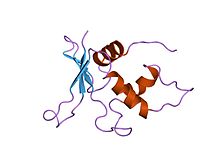Interferon regulatory factors
| Interferon regulatory factor transcription factor | |||||||||
|---|---|---|---|---|---|---|---|---|---|
 interferon regulatory factor-2 dna binding domain, nmr, minimized average structure | |||||||||
| Identifiers | |||||||||
| Symbol | IRF | ||||||||
| Pfam | PF00605 | ||||||||
| InterPro | IPR001346 | ||||||||
| SCOP2 | 1if1 / SCOPe / SUPFAM | ||||||||
| |||||||||
Interferon regulatory factors (IRF) are proteins which regulate transcription of interferons (see regulation of gene expression).[1] They are used in the JAK-STAT signaling pathway.[2] Interferon regulatory factors contain a conserved N-terminal region of about 120 amino acids, which folds into a structure that binds specifically to the interferon consensus sequence (ICS), which is located upstream of the interferon genes.[3] The remaining parts of the interferon regulatory factor sequence vary depending on the precise function of the protein.[3] The Kaposi sarcoma herpesvirus, KSHV,[4] is a cancer virus that encodes four different IRF-like genes;[5] including vIRF1,[6] which is a transforming oncoprotein that inhibits type 1 interferon activity.[7] In addition, the expression of IRF genes is under epigenetic regulation by promoter DNA methylation. [8]
Genes
See also
References
- ^ Paun A, Pitha PM (2007). "The IRF family, revisited". Biochimie. 89 (6–7): 744–53. doi:10.1016/j.biochi.2007.01.014. PMC 2139905. PMID 17399883.
- ^ Tsuneya Ikezu; Howard E. Gendelman (2008). Neuroimmune Pharmacology. Springer. pp. 213–. ISBN 978-0-387-72572-7. Retrieved 28 November 2010.
- ^ a b Weisz A, Marx P, Sharf R, Appella E, Driggers PH, Ozato K, Levi BZ (December 1992). "Human interferon consensus sequence binding protein is a negative regulator of enhancer elements common to interferon-inducible genes". J. Biol. Chem. 267 (35): 25589–96. PMID 1460054.
- ^ Chang Y, Cesarman E, Pessin MS, Lee F, Culpepper J, Knowles DM, Moore PS (December 1994). "Identification of herpesvirus-like DNA sequences in AIDS-associated Kaposi's sarcoma". Science. 266 (5192): 1865–9. Bibcode:1994Sci...266.1865C. doi:10.1126/science.7997879. PMID 7997879.
- ^ Offermann MK (2007). "Kaposi sarcoma herpesvirus-encoded interferon regulator factors". Curr Top Microbiol Immunol. Current Topics in Microbiology and Immunology. 312: 185–209. doi:10.1007/978-3-540-34344-8_7. ISBN 978-3-540-34343-1. PMID 17089798.
- ^ Moore PS, Boshoff C, Weiss RA, Chang Y (December 1996). "Molecular mimicry of human cytokine and cytokine response pathway genes by KSHV". Science. 274 (5293): 1739–44. Bibcode:1996Sci...274.1739M. doi:10.1126/science.274.5293.1739. PMID 8939871. S2CID 29713179.
- ^ Gao SJ, Boshoff C, Jayachandra S, Weiss RA, Chang Y, Moore PS (October 1997). "KSHV ORF K9 (vIRF) is an oncogene which inhibits the interferon signaling pathway". Oncogene. 15 (16): 1979–85. doi:10.1038/sj.onc.1201571. PMID 9365244.
- ^ Rotondo JC, Borghi A, Selvatici R, Magri E, Bianchini E, Montinari E, Corazza M, Virgili A, Tognon M, Martini F (2016). "Hypermethylation-Induced Inactivation of the IRF6 Gene as a Possible Early Event in Progression of Vulvar Squamous Cell Carcinoma Associated With Lichen Sclerosus". JAMA Dermatology. 152 (8): 928–33. doi:10.1001/jamadermatol.2016.1336. PMID 27223861.
External links
 Media related to Interferon regulatory factors at Wikimedia Commons
Media related to Interferon regulatory factors at Wikimedia Commons- Interferon+regulatory+factors at the U.S. National Library of Medicine Medical Subject Headings (MeSH)
